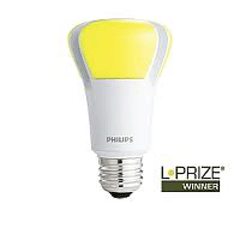Just in time for Earth Day, April 22: pricey LED bulb

More than 1 billion people around the globe are expected to take part in Earth Day 2012 festivities Sunday, April 22. Some may honor the day by paying almost $50 for a Philips LED 60-watt replacement bulb.
The Philips LED light bulb that goes on sale on Earth Day won the U.S. Department of Energy’s L Prize in 2011, a $10 million competition to replace the conventional incandescent bulb. The contest was open to manufacturers who could create a “green” but affordable light bulb. Contest rules required that parts of the bulb needed to be made in the U.S.
The Philips LED bulb design that won the L Prize saves energy. It uses just 10 watts of energy, has the same color quality as standard incandescent lights and lasts for 23 years. Industry experts say the bulb is brighter and renders colors better than its LED predecessors. The bulb offers an estimated savings of at least $6 in energy costs per year. Compared to traditional incandescent bulbs, the LED bulb leaves a much smaller carbon footprint.
According to the New York Daily News, a number of Home Depot stores in the U.S. will be selling the bulbs on Earth Day for $49.97 while supplies last. A variety of LED bulbs are available online.
The full retail price for the bulb after Earth Day is $60. Philips is discounting the price for bulbs purchased online.
Governments may find a variety of uses for the Philips LED bulb. One potential use: to replace bulbs in hard-to-reach, inaccessible areas. Because the bulb will not need to be replaced until 2035, there is more time to figure out the best way to tackle troublesome bulb replacements.
Government facility managers and procurement administrators are already shifting to LEDs from traditional lighting fixtures. “Our facilities management department is in the process of replacing all 8-foot fluorescent lamps with 8-foot LED bulbs,” says Paul Nobles, purchasing coordinator in Escambia County, Fla. Nobles told Govpro that the difference in wattage and the possibility of the LED lamps lasting five years were factors in making the switch from fluorescent tubes to LEDs.
“There are many government applications for LED lighting,” says Silvie Casanova, senior communications manager at Andover, Mass.-based Philips Electronics North America. “While the L Prize bulb is a specific replacement for an incandescent bulb, Philips makes a number of lighting solutions. The L Prize bulb can be used for table lamps, ceiling fans, floor lamps—anywhere you would normally use an incandescent. Think of its uses in government offices, army barracks, housing, etc.
“Moreover, we have over 24 kinds of LED bulbs, LED downlighting, commercial LED lighting systems that include daylight harvesting, occupancy sensing, control systems, and LED street lighting with motion sensing,” says Casanova. She says many LED lighting solutions exist that can meet energy and sustainability goals in government.
The federal General Services Administration (GSA), which serves as the federal government’s supply depot, has an extensive
green products compilation. The agency lists LED replacement bulbs in its
supply inventory, in
GSA Advantage, and as part of its
sustainable facilities tool.




















